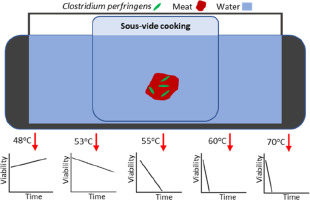当前位置:
X-MOL 学术
›
Int. J. Food Microbiol.
›
论文详情
Our official English website, www.x-mol.net, welcomes your
feedback! (Note: you will need to create a separate account there.)
The effect of low-temperature long-time (LTLT) cooking on survival of potentially pathogenic Clostridium perfringens in beef.
International Journal of Food Microbiology ( IF 5.0 ) Pub Date : 2020-01-28 , DOI: 10.1016/j.ijfoodmicro.2020.108540 Hani El Kadri 1 , Alaa Alaizoki 1 , Teyfik Celen 1 , Madeleine Smith 1 , Helen Onyeaka 1
International Journal of Food Microbiology ( IF 5.0 ) Pub Date : 2020-01-28 , DOI: 10.1016/j.ijfoodmicro.2020.108540 Hani El Kadri 1 , Alaa Alaizoki 1 , Teyfik Celen 1 , Madeleine Smith 1 , Helen Onyeaka 1
Affiliation

|
Low-temperature long-time (LTLT) cooking may lead to risk of potential survival of pathogenic bacteria such as Clostridium perfringens in cooked meat. In this study, the effect of LTLT cooking on C. perfringens was investigated at temperatures commonly used by caterers. Brain heart infusion broth (BHIB) and meat cubes in pouches (vacuumed or non-vacuumed) were inoculated with C. perfringens (NCTC 8238) and heated at temperatures of 48 °C, 53 °C, 55 °C, 60 °C and 70 °C. The viability of C. perfringens in BHIB and meat was monitored using plate counting and the D-value of each thermal treatment was determined. The recovery of C. perfringens after thermal treatment was assessed using optical density measurements. Flow cytometry analysis was used to assess the physiological status (death/injury) of C. perfringens cells in BHIB. The results showed that the required log reduction (6-log) of C. perfringens can be achieved at 55 °C but not at 48 °C or 53 °C. The D-values at all temperatures were higher in meat compared to BHIB while the D-value at 55 °C was higher in non-vacuum compared to vacuum sealed meat. C. perfringens cells were able to recover and grow to pathogenic levels when thermal treatment was unable to achieve the required 6-log reduction. In BHIB, percentage of dead cells increased gradually at 48 °C, 53 °C and 55 °C while an immediate increase (>95%) was observed at 60 °C and 70 °C. These results are important to food safety authorities allowing to set the time-temperature combinations to be used in LTLT cooking to obtain safe meat.
中文翻译:

低温长时间(LTLT)烹饪对牛肉中潜在致病性产气荚膜梭状芽胞杆菌存活的影响。
低温长时间(LTLT)烹饪可能会导致潜在的致病细菌(如熟肉中的产气荚膜梭状芽孢杆菌)存活。在这项研究中,研究了LTLT蒸煮对产气荚膜梭菌的影响,方法是在餐饮者通常使用的温度下进行。用产气荚膜梭菌(NCTC 8238)接种小袋(真空或非真空)的脑心浸液(BHIB)和肉块,并在48°C,53°C,55°C,60°C和70°C。使用平板计数法监测产气荚膜梭菌在BHIB和肉中的活力,并确定每种热处理的D值。使用光密度测量评估热处理后产气荚膜梭菌的回收率。流式细胞仪分析用于评估BHIB中产气荚膜梭菌细胞的生理状态(死亡/伤害)。结果表明,在55°C而不是48°C或53°C时,可以实现产气荚膜梭菌所需的对数降低(6-log)。与真空密封肉相比,在所有温度下肉中的D值均高于BHIB,而在55°C时非真空中的D值较高。当热处理不能达到所要求的6-log降低时,产气荚膜梭菌细胞能够恢复并生长到致病水平。在BHIB中,死细胞百分比在48°C,53°C和55°C时逐渐增加,而在60°C和70°C时则立即增加(> 95%)。这些结果对食品安全部门来说很重要,允许他们设置在LTLT烹饪中使用的时间-温度组合以获得安全的肉。与真空密封肉相比,在所有温度下肉中的D值均高于BHIB,而在55°C时非真空中的D值较高。当热处理不能达到所要求的6-log降低时,产气荚膜梭菌细胞能够恢复并生长到致病水平。在BHIB中,死细胞百分比在48°C,53°C和55°C时逐渐增加,而在60°C和70°C时则立即增加(> 95%)。这些结果对食品安全部门来说很重要,允许他们设置在LTLT烹饪中使用的时间-温度组合以获得安全的肉。与真空密封肉相比,在所有温度下肉中的D值均高于BHIB,而在55°C时非真空中的D值较高。当热处理不能达到所要求的6-log降低时,产气荚膜梭菌细胞能够恢复并生长到致病水平。在BHIB中,死细胞百分比在48°C,53°C和55°C时逐渐增加,而在60°C和70°C时则立即增加(> 95%)。这些结果对食品安全部门来说很重要,允许他们设置在LTLT烹饪中使用的时间-温度组合以获得安全的肉。当热处理无法达到所需的6-log降低时,perfringens细胞能够恢复并生长至致病水平。在BHIB中,死细胞百分比在48°C,53°C和55°C时逐渐增加,而在60°C和70°C时则立即增加(> 95%)。这些结果对食品安全部门来说很重要,允许他们设置在LTLT烹饪中使用的时间-温度组合以获得安全的肉。当热处理无法达到所需的6-log降低时,perfringens细胞能够恢复并生长至致病水平。在BHIB中,死细胞百分比在48°C,53°C和55°C时逐渐增加,而在60°C和70°C时则立即增加(> 95%)。这些结果对食品安全部门来说很重要,允许他们设置在LTLT烹饪中使用的时间-温度组合以获得安全的肉。
更新日期:2020-01-30
中文翻译:

低温长时间(LTLT)烹饪对牛肉中潜在致病性产气荚膜梭状芽胞杆菌存活的影响。
低温长时间(LTLT)烹饪可能会导致潜在的致病细菌(如熟肉中的产气荚膜梭状芽孢杆菌)存活。在这项研究中,研究了LTLT蒸煮对产气荚膜梭菌的影响,方法是在餐饮者通常使用的温度下进行。用产气荚膜梭菌(NCTC 8238)接种小袋(真空或非真空)的脑心浸液(BHIB)和肉块,并在48°C,53°C,55°C,60°C和70°C。使用平板计数法监测产气荚膜梭菌在BHIB和肉中的活力,并确定每种热处理的D值。使用光密度测量评估热处理后产气荚膜梭菌的回收率。流式细胞仪分析用于评估BHIB中产气荚膜梭菌细胞的生理状态(死亡/伤害)。结果表明,在55°C而不是48°C或53°C时,可以实现产气荚膜梭菌所需的对数降低(6-log)。与真空密封肉相比,在所有温度下肉中的D值均高于BHIB,而在55°C时非真空中的D值较高。当热处理不能达到所要求的6-log降低时,产气荚膜梭菌细胞能够恢复并生长到致病水平。在BHIB中,死细胞百分比在48°C,53°C和55°C时逐渐增加,而在60°C和70°C时则立即增加(> 95%)。这些结果对食品安全部门来说很重要,允许他们设置在LTLT烹饪中使用的时间-温度组合以获得安全的肉。与真空密封肉相比,在所有温度下肉中的D值均高于BHIB,而在55°C时非真空中的D值较高。当热处理不能达到所要求的6-log降低时,产气荚膜梭菌细胞能够恢复并生长到致病水平。在BHIB中,死细胞百分比在48°C,53°C和55°C时逐渐增加,而在60°C和70°C时则立即增加(> 95%)。这些结果对食品安全部门来说很重要,允许他们设置在LTLT烹饪中使用的时间-温度组合以获得安全的肉。与真空密封肉相比,在所有温度下肉中的D值均高于BHIB,而在55°C时非真空中的D值较高。当热处理不能达到所要求的6-log降低时,产气荚膜梭菌细胞能够恢复并生长到致病水平。在BHIB中,死细胞百分比在48°C,53°C和55°C时逐渐增加,而在60°C和70°C时则立即增加(> 95%)。这些结果对食品安全部门来说很重要,允许他们设置在LTLT烹饪中使用的时间-温度组合以获得安全的肉。当热处理无法达到所需的6-log降低时,perfringens细胞能够恢复并生长至致病水平。在BHIB中,死细胞百分比在48°C,53°C和55°C时逐渐增加,而在60°C和70°C时则立即增加(> 95%)。这些结果对食品安全部门来说很重要,允许他们设置在LTLT烹饪中使用的时间-温度组合以获得安全的肉。当热处理无法达到所需的6-log降低时,perfringens细胞能够恢复并生长至致病水平。在BHIB中,死细胞百分比在48°C,53°C和55°C时逐渐增加,而在60°C和70°C时则立即增加(> 95%)。这些结果对食品安全部门来说很重要,允许他们设置在LTLT烹饪中使用的时间-温度组合以获得安全的肉。











































 京公网安备 11010802027423号
京公网安备 11010802027423号